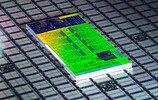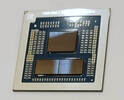Intel Core i7-14650HX vs AMD Ryzen 9 8940HX vs AMD Ryzen 7 8840HX
Intel Core i7-14650HX
► remove from comparison
The Intel Core i7-14650HX is a high-end CPU based on the new Raptor Lake architecture for large and heavy notebooks. The CPU was introduced at the beginning of 2024 and is similar to the older Core i7-13700HX except for slightly higher CPU clock rates (max 200 MHz).
The total of 24 threads are divided into P-cores and E-cores, which we already know from Alder-Lake. The 13700HX offers 8 performance cores (P-cores) with hyperthreading and 8 efficiency cores (E-cores) without hyperthreading. A total of 20 threads are therefore supported. The P-cores clock from 2.2 to 5.2 GHz (single core) or 4.5 GHz (all cores) and the E-cores from 1.6 to 3.7 GHz. The integrated memory controller supports a maximum of DDR5 with 4800 MHz (and not 5600 MHz like the i9 HX models).
Compared to Alder Lake, the new Raptor Lake architecture offers improved P-cores (Raptor Cove architecture with more cache), more E-cores (same Gracemont architecture) and higher clock rates thanks to the improved Intel 7 process. Furthermore, Intel now supports faster DDR5 main memory in the top models (up to 5600 MHz in the i9).
The performance should be slightly above the older Core i7-13700HX (with the same TDP settings and cooling). This makes the CPU ideal for demanding tasks and games.
The 14650HX continues to be manufactured using Intel's improved 10nm FinFET process (Intel 7 process) and is specified with 55 watts of base power and 157 watts of turbo power.
AMD Ryzen 9 8940HX
► remove from comparison
The AMD Ryzen 9 8940HX is a flagship 16-core Dragon Range refresh lineup laptop processor that debuted in April 2025. The product offers 16 SMT-enabled Zen 4 cores (32 threads) running at 2.4 GHz to 5.3 GHz, along with a rather basic Radeon 610M RDNA 2 architecture iGPU. This Ryzen 9 8000 APU is essentially a Ryzen 9 7940HX with the Turbo clock speed increased by 100 MHz.
The 8940HX is composed of three dies made on two different nodes (5 nm for CPU cores; 6 nm for other componentry). It features a very healthy 28 PCIe 5 lanes for connecting graphics cards and SSDs as fast as 15.75 GB/s. The RAM controller is limited to DDR5-5200 or slower; there is no NPU and no Thunderbolt support, the product page on amd.com indicates, but the clock multiplier is unlocked for easy overclocking.
Performance
While we have not tested a single system featuring the 8940HX as of April 2025, we do have some Cinebench benchmark scores for the 7940HX. Based on those, the newer Ryzen 9 should have no trouble beating the Core i9-13950HX, Core i9-13980HX and Core i9-14900HX.
That being said, with this many cores the APU will probably do a much better job serving content creators rather than gamers.
Power consumption
Much like the 7940HX, the 8940HX has a base TDP (long-term power limit) of 55 watts that can officially be jacked up to as high as 75 watts. To dissipate 50+ watts, at least one high-RPM fan is needed.
AMD Ryzen 7 8840HX
► remove from comparison
The AMD Ryzen 7 8840HX is a higher-end 12-core Dragon Range refresh lineup processor that debuted in April 2025 and is primarily targeted at gaming laptops. The product offers 12 SMT-enabled Zen 4 cores (24 threads) running at 2.9 GHz to 5.1 GHz, along with a rather basic Radeon 610M RDNA 2 architecture iGPU. This Ryzen 7 8000 APU is essentially a Ryzen 9 7845HX with the base clock speed and Turbo clock speed cut by 100 MHz each.
The 8840HX is composed of three dies made on two different nodes (5 nm for CPU cores; 6 nm for other componentry). It features a very healthy 28 PCIe 5 lanes for connecting graphics cards and SSDs as fast as 15.75 GB/s. The RAM controller is limited to DDR5-5200 or slower; there is no NPU and no Thunderbolt support, the product page on amd.com indicates, but the clock multiplier is unlocked for easy overclocking.
Performance
While we have not tested a single system featuring the 8840HX as of April 2025, we can take the 7845HX's multi-thread Cinebench scores and lower them by a percent or two. If we do that, the 8840HX emerges as a Core i7-14650HX and Core i7-14700HX-beating CPU which is fast enough for any 2025 or 2026 game.
Power consumption
Much like the 7845HX, the 8840HX has a base TDP (long-term power limit) of 55 watts that can officially be jacked up to as high as 75 watts. In fact, Alienware allows the 7845HX to consume well over 100 watts in its 2023 Alienware m16 (the only 7845HX system Notebookcheck has tested). Either way, to dissipate 50+ watts, at least one high-RPM fan is needed.
| Model | Intel Core i7-14650HX | AMD Ryzen 9 8940HX | AMD Ryzen 7 8840HX | ||||||||||||||||||||||||||||||||||||||||||||||||||||
| Codename | Raptor Lake-HX Refresh | Dragon Range refresh (Zen 4) | Dragon Range refresh (Zen 4) | ||||||||||||||||||||||||||||||||||||||||||||||||||||
| Series | Intel Raptor Lake-HX | AMD Dragon Range (Zen 4, Ryzen 7X4X/8X4X) | AMD Dragon Range (Zen 4, Ryzen 7X4X/8X4X) | ||||||||||||||||||||||||||||||||||||||||||||||||||||
| Series: Dragon Range (Zen 4, Ryzen 7X4X/8X4X) Dragon Range refresh (Zen 4) |
|
|
| ||||||||||||||||||||||||||||||||||||||||||||||||||||
| Clock | 1600 - 5200 MHz | 2400 - 5300 MHz | 2900 - 5100 MHz | ||||||||||||||||||||||||||||||||||||||||||||||||||||
| L2 Cache | 24 MB | 16 MB | 12 MB | ||||||||||||||||||||||||||||||||||||||||||||||||||||
| L3 Cache | 30 MB | 64 MB | 64 MB | ||||||||||||||||||||||||||||||||||||||||||||||||||||
| Cores / Threads | 16 / 24 8 x 5.2 GHz Intel Raptor Cove P-Core 8 x 3.7 GHz Intel Gracemont E-Core | 16 / 32 16 x 5.3 GHz AMD Zen 4 | 12 / 24 12 x 5.1 GHz AMD Zen 4 | ||||||||||||||||||||||||||||||||||||||||||||||||||||
| TDP | 55 Watt | 55 Watt | 55 Watt | ||||||||||||||||||||||||||||||||||||||||||||||||||||
| TDP Turbo PL2 | 157 Watt | ||||||||||||||||||||||||||||||||||||||||||||||||||||||
| Technology | 10 nm | CCD = 5nm, I/O = 6 nm | CCD = 5nm, I/O = 6 nm | ||||||||||||||||||||||||||||||||||||||||||||||||||||
| Die Size | 257 mm2 | ||||||||||||||||||||||||||||||||||||||||||||||||||||||
| max. Temp. | 100 °C | 100 °C | |||||||||||||||||||||||||||||||||||||||||||||||||||||
| Socket | BGA1964 | FL1 | FL1 | ||||||||||||||||||||||||||||||||||||||||||||||||||||
| Features | DDR4-3200/DDR5-5600 RAM, PCIe 5, Thr. Director, DL Boost, GNA, MMX, SSE, SSE2, SSE3, SSSE3, SSE4.1, SSE4.2, AVX, AVX2, BMI2, ABM, FMA, ADX, VMX, SMEP, SMAP, EIST, TM1, TM2, HT, Turbo, SST, AES-NI, RDRAND, RDSEED, SHA | DDR5-5200 RAM, PCIe 5, MMX, SSE, SSE2, SSE3, SSSE3, SSE4A, SSE4.1, SSE4.2, AVX, AVX2, AVX-512, BMI2, ABM, FMA, ADX, SMEP, SMAP, SMT, CPB, AES-NI, RDRAND, RDSEED, SHA, SME | DDR5-5200 RAM, PCIe 5, MMX, SSE, SSE2, SSE3, SSSE3, SSE4A, SSE4.1, SSE4.2, AVX, AVX2, AVX-512, BMI2, ABM, FMA, ADX, SMEP, SMAP, SMT, CPB, AES-NI, RDRAND, RDSEED, SHA, SME | ||||||||||||||||||||||||||||||||||||||||||||||||||||
| iGPU | Intel UHD Graphics 770 ( - 1600 MHz) | AMD Radeon 610M ( - 2200 MHz) | AMD Radeon 610M ( - 2200 MHz) | ||||||||||||||||||||||||||||||||||||||||||||||||||||
| Architecture | x86 | x86 | x86 | ||||||||||||||||||||||||||||||||||||||||||||||||||||
| Announced | |||||||||||||||||||||||||||||||||||||||||||||||||||||||
| Manufacturer | ark.intel.com | amd.com | www.amd.com | ||||||||||||||||||||||||||||||||||||||||||||||||||||
| L1 Cache | 1 MB | 768 KB |
Benchmarks
Average Benchmarks Intel Core i7-14650HX → 0% n=0
Average Benchmarks AMD Ryzen 9 8940HX → 0% n=0
* Smaller numbers mean a higher performance
1 This benchmark is not used for the average calculation













